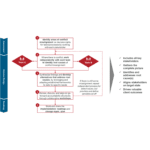
Key takeaways
-
Lack of standardization quietly undermines efficiency
-
Using too many applications can slow down operations instead of speeding them up
-
Unclear distribution of responsibilities and unmanaged ad-hoc requests erode capacity and clarity
1. Lack of standardization
Without clear, repeatable, and documented processes, businesses risk leaving the door open for operational waste. In the absence of standardized processes, employees are left on their own to figure out how to complete their tasks. Consequently, everyone on a team might complete the same work in a slightly different way.
In environments with a lack of standardization, employees are not typically trained to a uniform standard during their onboarding. Instead, they learn how one (or more) of their tenured colleagues completes the work through job-shadowing and on-the-job training. When this happens, variances in how work is completed will start to creep into operations. Over time, as details of job responsibilities are relayed to incoming team members, they are gradually altered with personal approaches and ways to stay organized (notes, archived emails, Excel macros, etc.). While processes appear ‘standardized’ as artifacts are iteratively created, evolved, and shared amongst the team, there is a distinct absence of deliberate design, oversight, and, most importantly, enforcement. Therefore, there is no requirement that all employees must follow a common standard.
Without standardization, employees may fall into some common, waste-generating traps. Aside from the extra time needed to figure out how to complete certain activities, we often see employees demonstrate instances of both over-and under-processing – each of which generates waste in its own way.
Over processors make the mistake of gold-plating their work, putting too much effort into their output, and wasting time over-delivering on the task at hand. While this may help ensure that an individual customer (internal or external) is happy with the results, there is no guarantee that the extra effort is needed or even appreciated. However, what is guaranteed is that the additional work will add unnecessary time to the task and reduce the efficiency of the employee and their team. Conversely, under processors do the exact opposite. In the absence of standardized processes, under processors make the mistake of cutting corners to complete their work quickly versus to a standard level of quality. When this happens, defects, and subsequently, complaints often follow. Not surprisingly, under processors drive waste due to the extra effort required to re-work and manage negative feedback received from customers.
2. A proliferation of applications
Often, teams use too many applications to complete their work. Despite the intended goal of simplifying processes and making lives easier, an overly robust technology stack can often complicate workflows and drive waste.
A 2018 study conducted by Pegasystems analyzed nearly 5-million hours of live desktop activity from a group of operational support workers and found that the average employee switched between 35 applications more than 1,100 times every day! Not surprisingly, the report found that these employees also completed an average of 134 copy-and-paste actions each day (something many teams are all too familiar with). Multiply these findings across your entire operation, and it’s not hard to see why an unruly list of applications can hinder efficiency.
However, the proliferation of software is a problem many businesses face and may happen for a few seemingly innocuous reasons. For example, perhaps a legacy application hasn’t been replaced due to its complexity and now requires a complement of additional tools (macros, databases, etc.) to expand capabilities and meet the changing needs of the business. Perhaps your organization has adopted a strategy of procuring ‘best of breed’ solutions versus integrated options driving up the total number of applications in use. Or perhaps different teams in your organizations are authorized to procure software outside centralized oversight, ultimately leading to redundancies (using Zoom, Microsoft Teams, and GoToMeeting for conferencing as an example).
Whatever the reason, it is ironic: technology intended to accelerate team efficiency can often do quite the opposite. In these situations, waste is generated due to the motion needed to routinely switch between multiple applications. This ‘app-jockeying’ may be required to find information fragmented across systems, cut and paste data needed to complete tasks, or investigate where potential breakdowns may have occurred in the vast landscape of systems. Over time, all those extra clicks, not to mention the additional seconds spent re-orienting to different applications, can add up, frequently resulting in an alarming amount of wasted time and effort across the team.
3. Unclear distribution of responsibilities and tasks
Despite appearing busy, your team might not be working on what they should be. Instead, they may be supporting a litany of requests which are over and above their defined mandate.
It usually starts innocently enough; a request that your team receives falls outside of your regular responsibilities. It should be as simple as just declining the ask or redirecting the requester elsewhere. However, after some internal deliberation – and often, pressure from your business partner – you decide to take on the extra assignment. The only problem is, situations like this are seldom ‘one-and-done’ and can easily grow to become a regular part of your team’s business-as-usual operations, taking team members away from their primary responsibilities. Over time, an overly permissive approach to handling ad hoc requests may have significant implications for your team and the volume of work they support.
Left unmanaged, ad hoc requests will quickly erode team productivity and demoralize both employees and managers alike. In these situations, teams effectively create waste due to over-production, completing work that falls outside their defined mandate. In our experience, we often hear the common complaint from senior and executive leaders that their teams appear busy, but they don’t know what they’re working on; in these cases, an abundance of ad hoc requests may be the culprit. Since these requests are frequently received ‘under the table,’ they are seldom tracked. As a result, they can quickly become problematic as teams gradually become unable to support both their visible and invisible workloads. Moreover, team managers can become frustrated during annual resource planning exercises when their requests for additional headcount are declined because they can’t quantify exactly why additional resources are needed, further compounding the problem. Sadly, this is a situation we see occur far too often.
4. Poorly defined decision rights
Teams can get stuck waiting for clear direction from their business partners. Ambiguous decision rights can quickly lead to internal conflicts and process bottlenecks.
Many operational teams face the challenge of too many people weighing in on a decision. Typically, these situations arise when processes require a high degree of collaboration and stakeholder involvement. As multiple teams are looped in, grey areas emerge, and ambiguity regarding who has the authority to make decisions enters the picture. When this happens, your team may find themselves facing two very distinct challenges. On the one hand, multiple stakeholders with differing points of view may lay claim over a particular decision. In this situation, conflict generally arises, and your team may be at the center of it, struggling to navigate the storm through to a suitable conclusion. Alternatively, the lack of clarity over decision rights may result in absolutely no one wanting to make the final decision due to the intrinsic risk of being held accountable for an undesirable outcome. In this situation, your team may again find themselves struggling. However, in this case, the struggle is to find someone with the authority to provide direction.
Lack of clarity around decision rights can grind productivity to a halt. This creates waste due to the time spent waiting for internal conflicts and challenges to be resolved before a team receives clear direction. Working through delays risks further bottlenecks later in the process once the team receives direction. Since most employees will naturally take on additional work while waiting, they may be faced with a challenge managing volume surges if (and, often, when) everything comes in all at once. If this happens, your staff may struggle to keep up with their workload and may further compound the problem by rushing and making errors impacting quality, which subsequently drive the additional waste in the form of defects and re-work.
While inefficiency can be everywhere, it may not be evident to the untrained eye. The challenges described above represent just a few ways inefficiency can sneak into your operations and drive waste day over day. If these problems resonate with you, and you would like to learn more about how Burnie Group can help diagnose and design an improved operation, please reach out to us for an introduction.
Frequently asked questions
What happens when an organization lacks standardization in its processes?
Without standardization, employees end up working inconsistently, each person applying their own approach, leading to inefficiency and unpredictability. Some might spend too much time polishing work (over-processing), while others might do too little and deliver poor quality or incomplete work (under-processing). Both extremes add waste, either through unnecessary effort or rework and complaints.
Why can adding more software tools harm operational efficiency instead of help?
While each new tool might be intended to make a specific task easier, when many tools accumulate they can create fragmentation. Employees may need to regularly switch between different applications, copy-paste data across systems, or search through multiple platforms to complete one workflow, all of which significantly increases time and complexity, reducing overall efficiency.
How does unclear assignment of responsibilities affect team performance and productivity?
When roles and decision rights are vague, teams often take on unexpected or informal tasks (ad-hoc requests), diverting resources from their core responsibilities. Over time, these hidden tasks add up, leading to overload, lack of accountability, confusion over who owns what, difficulty tracking workload, and challenges in resource planning or justifying additional headcount. This undermines overall efficiency and clarity.
Our insights on people & organizations
We can help you increase your operational efficiency.
CONTACT US




